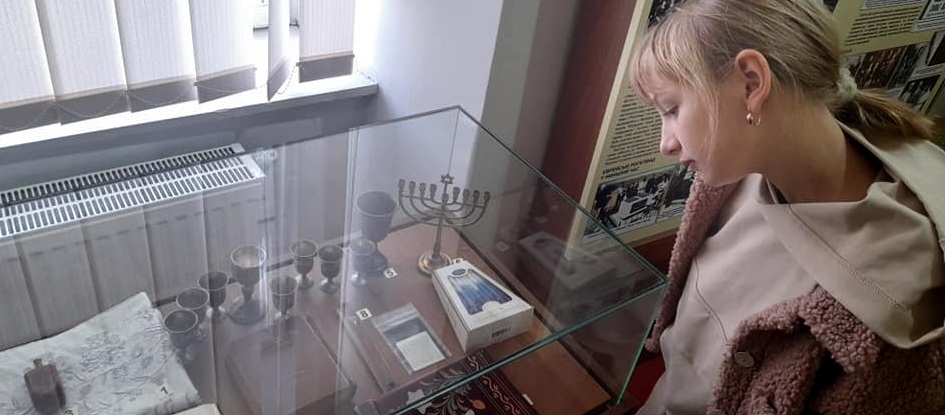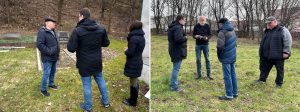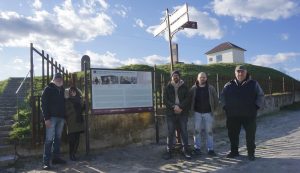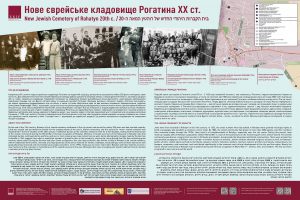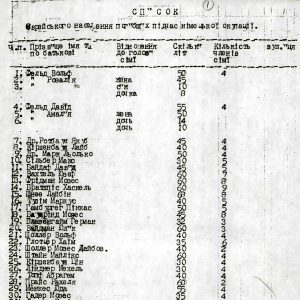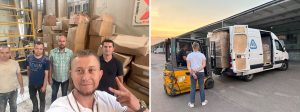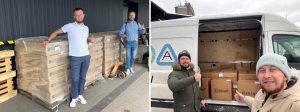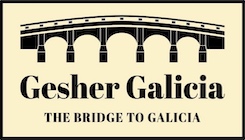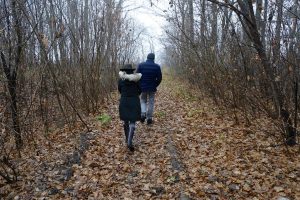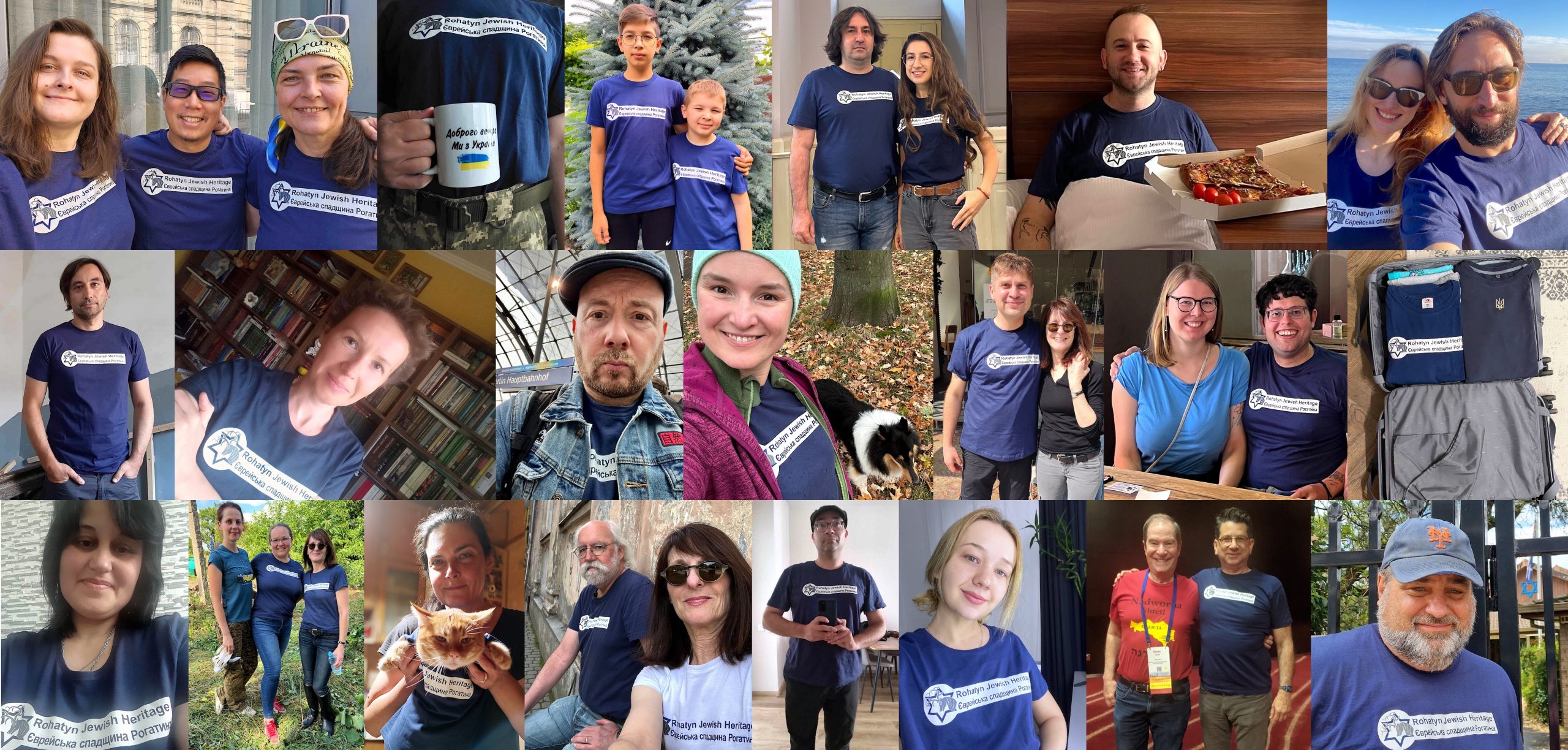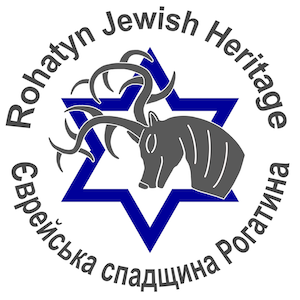 This is a descriptive annual report for Rohatyn Jewish Heritage (RJH) covering the calendar year 2023, our seventh consecutive year of operation as a volunteer-led non-profit NGO in Ukraine. As in past years, this report summarizes our project progress and events together with an outline of our NGO finances. This year continued the irregular operating mode of our organization caused by the ongoing Russian war of aggression in Ukraine. See our report for 2022 for comparison (prior years’ reports are also accessible in the news section of this website). Many sections of this review are hyperlinked to pages with more information, on or off of our website.
This is a descriptive annual report for Rohatyn Jewish Heritage (RJH) covering the calendar year 2023, our seventh consecutive year of operation as a volunteer-led non-profit NGO in Ukraine. As in past years, this report summarizes our project progress and events together with an outline of our NGO finances. This year continued the irregular operating mode of our organization caused by the ongoing Russian war of aggression in Ukraine. See our report for 2022 for comparison (prior years’ reports are also accessible in the news section of this website). Many sections of this review are hyperlinked to pages with more information, on or off of our website.
![]() Ця сторінка також доступна українською.
Ця сторінка також доступна українською.
RUSSIA’S WAR CONTINUES
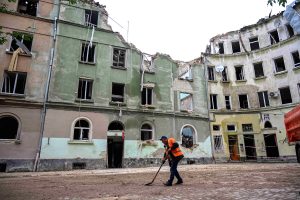
Damage to an apartment building in Lviv this year, where 10 civilians ultimately died from a Russian missile strike. Source: Human Rights Watch.
Again this year our heritage projects and our history and memory work were impacted by the ongoing criminal war Russia has inflicted on Ukraine. This war is being well documented in daily news from Ukrainian sources and in other resources with longer views. In the second half of last year we and others adapted to the loss of physical and financial resources and to frequent threats of bombardment in order to continue at some of our work. In 2023 western Ukraine suffered a series of direct explosive drone and missile attacks which repeatedly brought building damage and loss of life to Lviv, where we live; so far Rohatyn has been spared. Friends and colleagues in Kyiv and Kharkiv suffered far worse this past year, and of course nothing compares to the nightmarish life near the long front battle line.
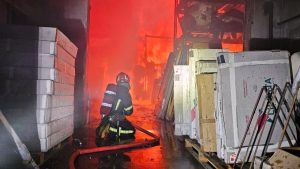
Fire destroys warehouses in Lviv following a Russian drone attack which killed one worker this year. Source: Ukraine MIA via Kyiv Post.
The snows of winter came early and heavy this year and with them the risk of Russian attacks on electrical, gas, and hot water supplies everywhere in Ukraine. Our project’s physical work normally goes dormant during winter in favor of research and planning for spring; 2024 will be no exception, and we will wait for the snow and ice to clear before coming out of hibernation. In the meantime we join our colleagues in solidarity and determination to last out the war, and to restoration of an unbroken and undivided independent Ukraine.
CLEARING AND CARE OF THE JEWISH CEMETERIES AND MASS GRAVE SITES
This was the first year that all of the care and maintenance of the Jewish burial sites in Rohatyn was managed for us by two local men working for hire. We began this approach as a trial last year and were very pleased with the results, so we renewed the working relationship this year with the same men and they served our needs well throughout the vegetation growing season, from mid-spring to mid-autumn.
Our news report from the end of the growing season records the details of this year’s effort (which included removal of some large trees overhanging the north mass grave memorial monuments) with a number of photos of the four sites (two cemeteries and two mass graves) and of the men who did the work. We are grateful to both Ihor Zalypko and Vasyl Yurkiv for their hard work this year, and we are pleased that they have both agreed to continue similarly for us in 2024. Because these men are doing the heavy work for us now, we gave each of them one of the motorized brushcutters which we bought five years ago; the tools are worn from heavy use but still work very well. It’s a significant benefit for us that each of the men lives very near one of the Jewish cemeteries, and can keep an eye on the sites to alert us for any needed maintenance or repairs.
Curiously and for the first year since we began visiting Rohatyn for heritage work in 2011, in 2023 we recovered not a single Jewish headstone from areas of town outside the two Jewish cemeteries. Normally we are notified via Facebook or through friends and colleagues in Rohatyn and Lviv that headstones or fragments have been discovered in road works, in private home and outbuilding reconstruction, or in rubble by roadsides and the local waterways. We suppose that a strong reason may be that everyone (including us) is working differently during the war, and that both the City and private property owners have postponed the kinds of projects which would normally reveal repurposed headstones. We still have many friends in Rohatyn who have notified us of discovered stones in past years, so we are confident that when stones are found, we will hear and be able to respond.
HERITAGE SIGNS FOR THE JEWISH CEMETERIES
Our first physical project of 2023 was the long-awaited installation of large-format information signs at Rohatyn’s two Jewish cemeteries. In 2022 we partnered with the NGO ESJF European Jewish Cemeteries Initiative for layout and fabrication of the signs from our designs, and in late March this year a small ESJF construction crew anchored the new signs just outside the two cemeteries, bringing to conclusion a project which was three years in development (with delays caused by RJH and ESJF displacement for Covid-19 and the current war).
The signs incorporate our English-language texts about the history of Rohatyn’s Jewish community and about the individual cemeteries, with translations to Ukrainian by our friend Natalia Kurishko and to Hebrew by Rohatyn descendant Ruthy Erez. The signs are enhanced by a map of the Jewish and other heritage sites in Rohatyn, and by a handful of prewar photographs of Rohatyn Jewish family members generously donated by Rohatyn descendants, members of the online discussion association and web resource the Rohatyn District Research Group (RDRG).
The signs provide historical context for visitors to the two cemeteries, whether Jewish and other tourists or the Rohatyn region population. Based on the success of this project, Marla and I are now considering whether similar signs could be placed at the two Jewish mass graves in Rohatyn, as a possible future project.
REMEMBERING LOCAL HOLOCAUST VICTIMS
Despite the war we resolved to hold memorial ceremonies at both of the Rohatyn Jewish mass grave sites this year on dates which recall the two largest Holocaust killing events in the city, and we are grateful that we were joined for both of these commemorations by friends (both local and from Lviv) and by colleagues in the Connecting Memory program.
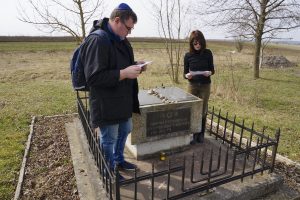
Sasha and Marla reading a prayer and a message of commemoration during the ceremony at the south mass grave. Photo © RJH.
At the grave site south of Rohatyn, on March 20 we observed the 81st anniversary of the first major aktion during the German occupation, during which more than 3000 Jewish citizens of Rohatyn and nearby villages were executed in a single day. Marla and I were joined for a prayer and a commemorative speech by Oleksandr (Sasha) Nazar, director of the Sholem Aleichem Jewish Cultural Society of Lviv and a long-time Jewish heritage activist in the region; by our mentor in the Connecting Memory program Olha Honchar, director of the Territory of Terror Museum (Територія Терору) in Lviv and coordinator of the Museum Crisis Center (Музейний кризовий центр) since the full-scale Russian invasion of Ukraine last year; and by Alex Dunai, a Jewish genealogist and family history researcher, and our friend for many years.
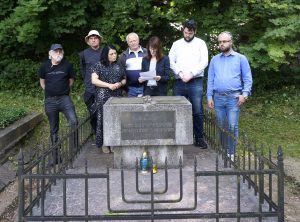
Gathered at the memorial monument for the victims of the ghetto liquidation and other killings. Photo © RJH.
On June 6th we marked the 80th anniversary of the start of the Rohatyn Jewish ghetto liquidation during which thousands of Jews from Rohatyn and many towns in the Rohatyn district were assembled, marched, and killed at a clay quarry site (today the city’s vodokanal) north of the city over three days. We were joined for this solemn ceremony by our friend Wito Nadaszkiewicz who serves as our NGO’s attorney and administrator, and who is a longtime regional heritage advocate; by Taras Grytsiuk, one of four leaders of the German-Ukrainian Connecting Memory program; by Joel Wasserman, an American journalist with Jewish roots in nearby Stryi who currently lives and works in Ukraine; by Tetiana Petriv, director of Rohatyn’s UNESCO-listed Holy Spirit Church and Museum of Prykarpattian Art; by Ihor Zalypko, engineer at Rohatyn’s vodokanal and who for the past several years has been caring for the Jewish mass grave sites in Rohatyn; and again by Alex Dunai, friend, lecturer, and family researcher.
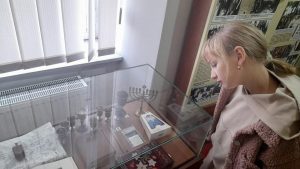
A schoolgirl looking at the display of Jewish artifacts at Rohatyn’s Opillya Museum. Source: Rohatyn Brothers Lyceum.
Our hope to enhance physical protection of the mass graves, especially at the south site, remains on indefinite hold for lack of the significant funds needed to undertake the construction work and because of the ongoing constraint of the war. Fortunately, the grave sites continue to get needed regular attention and care, and the war has heightened local awareness of the Holocaust (due to clear parallels between Nazi and recent Russian criminal actions in occupied areas) so the sites are receiving more local visitors, including school classes for annual days of Holocaust remembrance.
Efforts to advance legal registration and protection of the Jewish mass grave sites in Rohatyn continue, but very slowly due to overwhelmed regional authorities. This effort is led by our NGO attorney and friend Wito Nadaszkiewicz, with specialist legal advice through the Connecting Memory program. The most important task for us on this project during wartime is simply not to lose ground in the process.
RESEARCH AND REVIEW OF ROHATYN-AREA HISTORICAL DATA AND MEMOIRS
Constrained this year as we were during 2022, we again shifted more of our work to historical research and investigation of other intangible resources, particularly associated with the Holocaust in Rohatyn. Last year we detailed two Soviet reports with testimony from 1944 and 1945 and tabulated the names of victims (both Jewish and Ukrainian), one partially covering wartime victims in the city of Rohatyn and the other covering victims in villages in the Rohatyn district. This year, with the help of Dr. Alexander Feller of the RDRG and our longtime RJH colleague Vasyl Yuzyshyn we “scrubbed” and published an extensive list of Jewish Holocaust victims from Rohatyn and matched the names to the Yizkor Book’s martyr list (and its recent expanded republication) as well as to known family names being researched by members of the RDRG.
The list is preserved in the Ukrainian regional archive in Ivano-Frankivsk but originates from an unknown historical source with excellent knowledge of the Rohatyn Jewish community; the list was incorrectly labeled at the archive (and in some copies, for example at Yad Vashem), so its value went unrecognized until recently. The importance of this list is without parallel among the Soviet reports for the Rohatyn region and other original records: more than 1000 Jewish heads of households are named, and with their families nearly 5000 victims are counted in total.
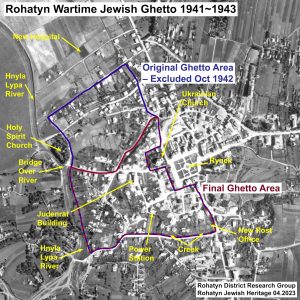
A provisional map of the wartime Rohatyn Jewish ghetto boundaries in their original and contracted states.
Another research project we undertook this year, with significant support from academic historians and researchers associated with the Connecting Memory project, was a study of the history and the geographic boundaries of Rohatyn’s wartime Jewish ghetto. This question has been of significant interest both to Jewish descendants and to current residents and local historians in Rohatyn. As there are no surviving original records of the ghetto (if there even were any defining wartime documents), the research effort involved review of all known relevant indirect materials, including the Rohatyn Yizkor Book and the Pinkas ha-kehillot Polin, individual Jewish memoirs, selected European and American academic histories of the region, Yahad – In Unum interviews with Ukrainian eyewitnesses, a Rohatyn newspaper published during the German occupation, Soviet reports, and a Luftwaffe aerial photograph taken after the ghetto was liquidated; in all, 15 separate sources were used. Some of the limited data conflicted in different sources, but it was possible to assemble a timeline of the evolution of the ghetto boundaries, a provisional map of those changes, and a brief description of the horror of ghetto life from the words of the imprisoned victims.
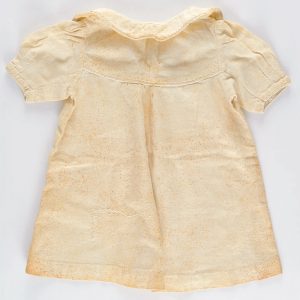
A dress which figures in the memoir by Dina Dor-Kasten. Source: Yad Vashem Artifacts Collection.
In 2023 we also published reviews of a few important memoir-related materials, including an oral interview with Rohatyn Jewish ghetto survivor Klara Schnytzer, the German translation of Dina Dor-Kasten’s original Hebrew memoir of survival in a forest near Bukachivtsi, and the memories of renowned Ukrainian author Roman Korytko about his childhood in Cherche near Rohatyn, and what he saw as the Germans gathered Jewish victims for execution during the liquidation of the Rohatyn ghetto.
The major event for us on memoirs this year was undoubtedly the bilingual print publication and distribution of Jack Glotzer’s personal history, I Survived the German Holocaust Against All Odds. As we reported last year, the memoir which we had previously published with Jack’s son Mitchell Glotzer in digital (pdf and web) formats was re-edited, augmented with additional historical references, and developed in a handsome Ukrainian and English print version by Vitalii Bobrov and others at the Ukrainian Center for Holocaust Studies (UCHS) in Kyiv, the leading Holocaust research organization in Ukraine.
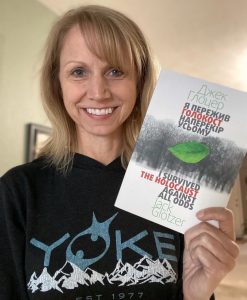
Our friend Rachel McRae, who copy-edited the English part of the book, with her copy of the print edition.
Development, printing, and free distribution to schools, libraries, and other educational institutions was completely funded by the Connecting Memory program. To support our work in Rohatyn, copies were shipped to us for distribution through the Rohatyn central library to the many rural libraries in the district and to teachers at Rohatyn schools, thanks to coordination by the staff of the central library. We also delivered copies to key contacts in and around Rohatyn and Lviv including the Rohatyn Opillya Museum, the Territory of Terror Museum in Lviv, the Tempel synagogue in Ivano-Frankivsk, and many individuals who have supported our work over the years in Ukraine, Poland, Germany, and the United States; we also shipped a small number of copies to Mitchell Glotzer in California for distribution within his family and to people and organizations connected to his father’s story and his parents’ Holocaust education work, including the USHMM. The book is available in Ukraine from the UCHS, and online in a complete illustrated pdf format in the UCHS Library of Holocaust Memoirs.
THE CONNECTING MEMORY PROGRAM COMES TO A CLOSE
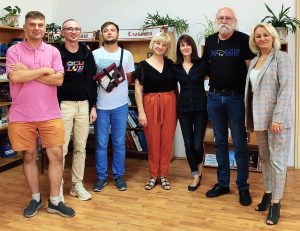
Organizers of the documentary film and discussion event at the library. Photo courtesy Rohatyn Central Library.
The Ukrainian-German program Connecting Memory which has provided support for local Holocaust commemoration projects came to an end this month, three years after we applied to and joined the program in 2021 with colleagues in Rohatyn and Lviv. This was the third phase of the program for the organization’s coordinators, which gave many kinds of support to projects all over Ukraine, especially on topics of research, education, and the engagement of local citizens in strengthening Holocaust remembrance. The coordinators, working from their offices at NGOs in Kyiv, Berlin, and elsewhere, plus our team’s mentor Olha Honchar of the Memorial Museum of Totalitarian Regimes “Territory of Terror” in Lviv, gave outstanding guidance and material support to more than 30 small projects during the program term, despite severe complications and disturbances due to the Covid-19 pandemic and Russia’s relentless military attacks on Ukrainian civilian life and safety.
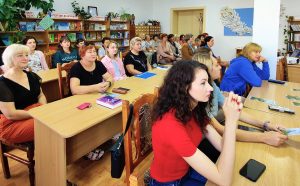
Some of the documentary film event participants in the reading room. Photo courtesy Rohatyn Central Library.
We have detailed some of the many ways Connecting Memory aided our work in prior annual reports, and above for this year: joining us for commemoration events at the Rohatyn mass grave sites, legal advice on heritage site registration, advice and resources for historical research, funding the development and print publication of the Jack Glotzer memoir, and importantly, providing experienced critical perspective in the midst of an ongoing war. Another key event this year organized and led by Connecting Memory was the presentation of a Holocaust documentary about the city of Turka (Lviv oblast) and a guided discussion led by one of the film’s authors (for the Ukrainian NGO After Silence), a coordinator from Connecting Memory, and a journalist and educator on intercultural dialog and civil society engagement in the Rohatyn region’s head city of Ivano-Frankivsk. The event was hosted by the Rohatyn central library and attended by more than 20 members of the Rohatyn community, several of whom joined the discussion to relate their perspectives on Rohatyn during and since the Holocaust.
Many of the projects our NGO has worked on in the past three years with support from Connecting Memory will continue in some form in the coming years. We are extremely grateful for the wisdom and resources the organization brought to our work in Rohatyn, and we hope to keep a strong connection with each of the key coordinators and our mentor as well, even informally.
LOOKING FORWARD: CONTINUING AND NEW PROJECTS
Long-term planning remains difficult under the current circumstances. We remain hopeful that Ukraine will prevail in the war and recover both its territorial integrity and its economic viability, but we understand that an end to the terror may be a long time away. In this situation we are considering the following projects for 2024:
- ongoing vegetation clearing and maintenance at the Jewish cemeteries and the mass grave sites
- as-needed Jewish headstone recovery where and when fragments are found
- 82-year commemoration at the south mass grave (20 March 2024)
- 81-year commemoration at the north mass grave (6 June 2024)
- continuing steps toward identification and registration of the mass grave sites in the national register of immovable heritage of Ukraine
- continuing research and reporting on the prewar Jewish community of Rohatyn
- design, translation, and installation of information signs at the two Jewish mass grave sites
- final development and publication of an online multi-town recovered Jewish headstone database application for western Ukraine, and initial entries for Rohatyn with input from descendants
While large physical projects in Rohatyn are currently difficult or impossible, we hope to begin smaller physical projects (e.g. signs for the mass grave sites) and continue research and digital projects, as noted, along with annual burial site care and commemoration. The headstone database application project is already in development by our colleague Vasyl Yuzyshyn and with the volunteer support of friends and colleagues in western Ukraine and Israel; we are hopeful that will become yet another way to connect the Jewish physical heritage of Rohatyn to descendants and researchers abroad.
ADMINISTRATION
Administrative work for RJH was again relatively light this year, as our NGO remains somewhat hindered by the war. Wito Nadaszkiewicz’s firm LawCraft Legal Services and Consulting in Lviv continues to maintain our NGO in legal and tax compliance with Ukraine’s laws, as it has since our incorporation in late 2016, and he manages all other corporate administration for us as well.
In parallel to continuing his firm’s law practice, Wito and his staff lawyer Bohdan Zdanevych continued to work nearly to exhaustion to bring humanitarian aid (food, clothing, toiletries, heaters, etc.) into Ukraine for benefit of the civilians who are internally displaced or who are trapped in villages near the front battle lines, as well as military reconnaissance equipment, specialized clothing and medical devices, trucks and fire engines, and much more. Funded via Polish charities such as Poland Helps and Siepomaga , Bohdan’s Ukrainian charity organization “You Will Never Be Alone”, as well as individual donors such as Marla and me, and with many long trips driven all across Ukraine by Bohdan, Wito, and their volunteer colleagues, their strenuous efforts are having truly positive impact and are a priority over any of our NGO work.
Wito again held RJH NGO legal and administrative expenses very low this, waiving many costs for us, a significant ongoing charitable gift to our small organization.
FINANCE
Since the legal founding of RJH we have maintained dual-track US and Ukrainian bank accounts to keep our NGO flexible and reliable in receiving donations and covering project expenses. We aim for transparency by publishing our NGO income and expenses here, as in past years. We also record and acknowledge all donations (20 individual donations in 2023), and every donation goes directly to project expenses (less banking and transfer fees). Marla and I contribute additional money from our personal savings to cover all administrative, tax, and operational costs, including our own salaries, plus some incidental project expenses (we are personally funding the non-Rohatyn portion of the headstone database project).
Donations were lower this year than in 2022, and the lowest of any year since we incorporated our NGO; one couple donated two-thirds of our total income this year. Project expenses exceeded donations this year, reducing the funds we have on hand for next year’s projects.
NGO income and expenses for the calendar year 2023 are listed below in US$ and using a nominal exchange rate of US$1=37UAH to allow for transfer fees and rate fluctuation:
NGO projects & operations: US+UA bank accounts start balance: +$13,028 --------------------------------------- burial sites groundskeeping -$ 2,677 headstone recovery -$ 0 misc. project labor -$ 161 tools, parts & accessories -$ 99 ground transport Lviv/Rohatyn -$ 785 transcription & translation -$ 1,471 signage: design, const, erect -$ 150 printing, books, archive fees -$ 22 project legal services -$ (comp) website domain, hosting, apps -$ 527 banking & wire transfer fees -$ 0 --------------------------------------- net change 2023: -$ 5,892 carryover 2022 expenses debt -$ 0 individual donations via GG +$ 4,496 other donations +$ 0 --------------------------------------- end project banking balance: +$11,632 2023 unreimbursed expenses -$ 0 --------------------------------------- net end project balance: +$11,632 [balance = +$4,937 US, +$6,695 UA, -$0 debt] NGO administration, salaries, etc.: UA bank account start balance: +$ 5,517 --------------------------------------- permit and gov't fees -$ 247 accounting and bank fees -$ 1,420 salaries+benefits+taxes -$ 5,460 --------------------------------------- net change 2022: -$ 7,127 Osborn personal contribution +$ 0 --------------------------------------- end admin balance: -$ 1,610
As always, the figures shown here are current, and may include updates since first reporting to include late-year donations or expenses, and a final reckoning by our NGO accountant.
Again this year we gladly and gratefully thank Gesher Galicia for its volunteer contributions, and in particular their PayPal Administrator and Operations Manager Shelley Kellerman Pollero, CFO/Treasurer Darcy Stamler, and President Steven Turner, for making the donations process to Rohatyn Jewish Heritage tax-deductible for US taxpayers and simple for everyone.
Marla and I continued to volunteer our own time throughout the year to support project work and administration of the NGO in Ukraine and from the US. We will continue in 2024 however we can.
THANK YOU TO OUR SUPPORTERS
Despite working differently and with fewer working visits to Rohatyn this year, it remains clear to Marla and me how much our work depends on our supporters, including those who volunteer with us working in Rohatyn and the region, those who donate to cover the costs of our project work, and those who share ideas and encouragement with us as we continue our efforts.
Often we highlight some of our supporters at events in news articles through the year, but of course there are others whose volunteer work is typically elsewhere and not captured in photos. Among those people we would like to mention our dear friend and core RJH team member Vasyl Yuzyshyn, who this year has been helping us with a wide variety of project work remotely, from research support to OCR conversion of texts to translations from Ukrainian and WWII-era Russian to software application development, and as always a large number of small problem-solving tasks. Besides being a great friend and a wonderful companion, Vasyl is the trusted mechanic who keeps our machinery running, both literally and figuratively.
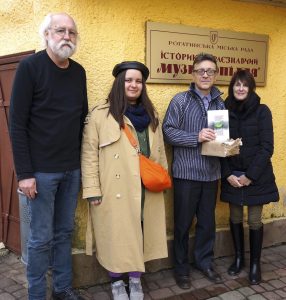
Delivering copies of the Jack Glotzer memoir to the Rohatyn Opillya Museum with our Connecting Memory mentor Olha Honchar. Photo © RJH.
It is with pride and admiration that Marla and I have watched our friends and colleagues help each other and their fellow citizens across Ukraine during this long and grinding war. Somehow each of them continues to contribute to war relief directly or indirectly while caring for their families and managing their work. We encourage anyone who can to help them help each other and bring this war to a positive end.
We are grateful that we continue to receive both tangible and intangible support from the City of Rohatyn and from our NGO partners (and friends) the Sholem Aleichem Jewish Cultural Society of Lviv, the Lviv Volunteer Center (LVC), ESJF European Jewish Cemeteries Initiative, the Ukrainian Center for Holocaust Studies (UCHS), the coordinators and the institutions of Connecting Memory, Yahad – In Unum, the Rohatyn Central Library, the Rohatyn Opillya Museum, the Rohatyn District Research Group (RDRG), and Gesher Galicia.
We would like to again acknowledge the many individual donors who provided funding this year to sustain our work in Rohatyn, many of whom have donated in years past as well. We are pleased and proud to list this year’s and past donors on our website.
At the end of another dark year, we will finish on an image which makes us smile. Although we held no large volunteer events in Rohatyn this year, we still managed to meet with many supporters who work in or transit the region and who wear our colors with pride. We say thank you again to everyone who continues to travel parallel paths of remembrance, preservation, and cooperation.
